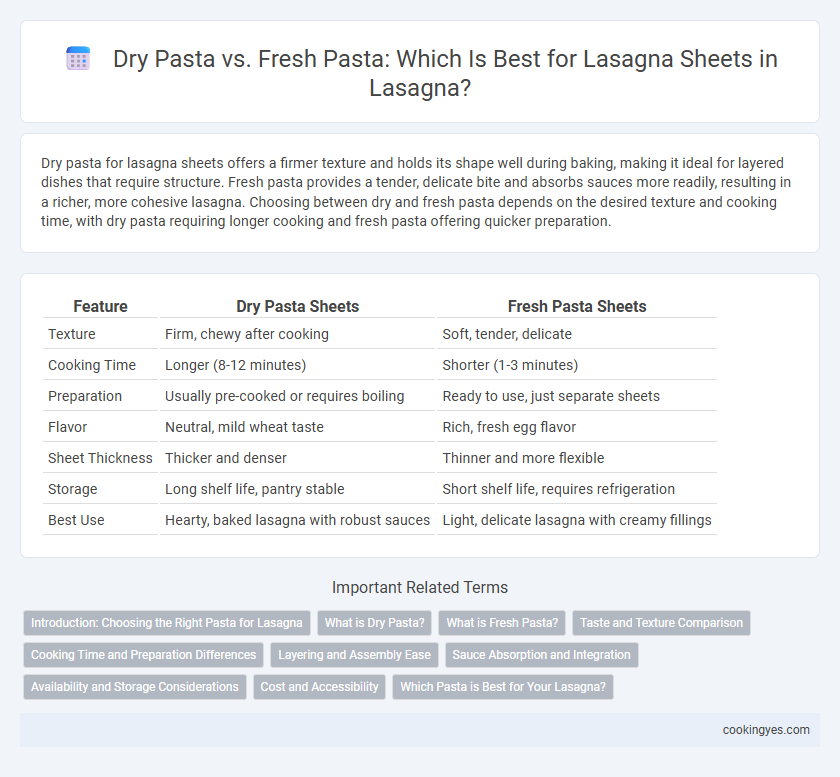Dry pasta for lasagna sheets offers a firmer texture and holds its shape well during baking, making it ideal for layered dishes that require structure. Fresh pasta provides a tender, delicate bite and absorbs sauces more readily, resulting in a richer, more cohesive lasagna. Choosing between dry and fresh pasta depends on the desired texture and cooking time, with dry pasta requiring longer cooking and fresh pasta offering quicker preparation.
Table of Comparison
| Feature | Dry Pasta Sheets | Fresh Pasta Sheets |
|---|---|---|
| Texture | Firm, chewy after cooking | Soft, tender, delicate |
| Cooking Time | Longer (8-12 minutes) | Shorter (1-3 minutes) |
| Preparation | Usually pre-cooked or requires boiling | Ready to use, just separate sheets |
| Flavor | Neutral, mild wheat taste | Rich, fresh egg flavor |
| Sheet Thickness | Thicker and denser | Thinner and more flexible |
| Storage | Long shelf life, pantry stable | Short shelf life, requires refrigeration |
| Best Use | Hearty, baked lasagna with robust sauces | Light, delicate lasagna with creamy fillings |
Introduction: Choosing the Right Pasta for Lasagna
Dry pasta lasagna sheets offer a firmer texture and longer shelf life, making them ideal for layered dishes that require extended baking times. Fresh pasta sheets provide a delicate, tender bite and cook faster, enhancing the overall creaminess of the lasagna. Selecting between dry and fresh pasta depends on the desired texture, cooking time, and flavor absorption preferences for your recipe.
What is Dry Pasta?
Dry pasta for lasagna sheets is made from durum wheat semolina and water, then shaped and dried at low temperatures to preserve quality and shelf life. It offers a firm texture and requires longer cooking times compared to fresh pasta, absorbing sauces well without becoming mushy. Popular for its convenience and extended storage, dry pasta is widely used in traditional Italian lasagna recipes.
What is Fresh Pasta?
Fresh pasta for lasagna sheets is made from a simple mixture of flour, eggs, and water, resulting in a tender, pliable texture that cooks quickly and absorbs sauces effectively. Unlike dry pasta, fresh pasta retains higher moisture content, providing a delicate bite and richer flavor profile that enhances the layers of traditional lasagna dishes. Its elasticity allows for seamless layering and even cooking, making it a preferred choice for recipes emphasizing texture and freshness.
Taste and Texture Comparison
Fresh pasta sheets for lasagna offer a tender, delicate texture that absorbs sauces more effectively, enhancing overall flavor richness. Dry pasta sheets provide a firmer bite and maintain structural integrity during baking, resulting in distinct layers and a satisfying mouthfeel. Taste differences are subtle, with fresh pasta delivering a slightly eggier, more nuanced flavor, while dry pasta has a neutral profile that allows sauce dominance.
Cooking Time and Preparation Differences
Dry pasta lasagna sheets require longer cooking times, typically 10-15 minutes of boiling before assembling the dish, whereas fresh pasta sheets cook much faster, usually in 1-2 minutes. Fresh pasta offers a tender texture and absorbs sauces more effectively but demands immediate use or proper storage to prevent drying out. Dry pasta is convenient for longer storage and often used without pre-boiling when baked in sufficiently moist lasagna recipes, making preparation simpler but affecting final texture.
Layering and Assembly Ease
Fresh pasta sheets for lasagna offer greater flexibility and softness, making layering and assembly smoother and less prone to tearing compared to dry pasta. Dry pasta sheets require pre-cooking or soaking to achieve the right pliability, which can complicate the assembly process and increase preparation time. Choosing fresh pasta often results in a more seamless layering experience, enhancing the overall texture and uniformity of the lasagna.
Sauce Absorption and Integration
Dry pasta sheets for lasagna typically absorb sauce more effectively due to their porous texture, allowing flavors to penetrate and meld throughout the layers. Fresh pasta, with its higher moisture content and smoother surface, tends to integrate less sauce, resulting in a creamier and more delicate texture. Choosing between dry and fresh pasta impacts the overall sauciness and mouthfeel of the lasagna, influencing how well the flavors combine.
Availability and Storage Considerations
Fresh pasta sheets for lasagna offer a tender texture and cook quickly but require refrigeration and have a short shelf life, typically lasting only a few days. Dry pasta sheets are widely available, shelf-stable for months or even years, and ideal for long-term storage without refrigeration. Choosing between dry and fresh pasta depends on convenience, storage capacity, and desired texture for the lasagna dish.
Cost and Accessibility
Dry pasta lasagna sheets offer a cost-effective and widely accessible option, available in most supermarkets with a longer shelf life, making them ideal for budget-conscious cooks. Fresh pasta tends to be pricier due to its perishable nature and limited availability, often found in specialty stores or fresh pasta sections. The ease of storage and year-round accessibility of dry pasta make it a practical choice for many households seeking convenience without compromising on quality.
Which Pasta is Best for Your Lasagna?
Fresh pasta sheets offer a delicate texture and rich flavor that absorb sauces well, making them ideal for traditional, homemade lasagna recipes. Dry pasta sheets provide convenience and longer shelf life while maintaining a firmer bite after baking, suitable for quick meals or large batch cooking. Choosing between fresh and dry pasta depends on your preference for texture, preparation time, and recipe authenticity.
Dry Pasta vs Fresh Pasta for Lasagna Sheets Infographic

 cookingyes.com
cookingyes.com